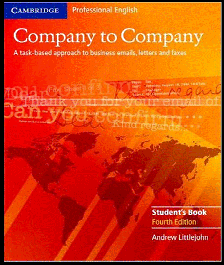
The 4th edition of this highly successful and well-regarded title brings the content fully up-to-date by taking account of recent developments in written communication. The course now features thorough guidance on email, as well as the more traditional forms of business letters and faxes.
The course features a task- and discussion-based methodology. The eight units in the course are each divided into three ections. The 'Study section' presents and practises the language of business correspondence. The 'Activity section' provide opportunities for students to be involved in decision-making discussions and to practise writing to each other in groups in a business simulation. The 'Writing process' section helps students to develop different strategies in their approach to writing, draft, and revising.
The Teachers's book contains guidance in using the course, answers, an outline of the simulations and model letters, photocopiable tests, and notes on business correspondence.
Download the contents lists: Student's Book Teacher's Book
Download a sample unit: Student's Book Teacher's Book
Chapter Contents
Unit 1 Making enquiries
1A Study section: Emails, opening/closing a message, subject headings, asking for information, email style, being polite
1B Activity section: Misplaced orders
1C The writing process: Getting help
Unit 2 Business prospects
2A Study section: Attachments, parts of a message, beginning and ending; email conventions
2B Activity section: A business trip
2C The writing process: Steps in writing a message.
Unit 3 Contacting customers
|
3A Study section: Referring, good/bad news, what you can/cannot do, giving reasons, British/American English, paragraphs
3B Activity section: Holiday time
3C The writing process: Writing a plan
Unit 4 When things go wrong
4A Study section: Letter layout, the date, making complaints, making a point, warning, making a strong complaint
4B Activity section: Who's responsible?
4C The writing process: Read before you write
Unit 5 Getting things done
5A Study section: Requesting action, apologising, faxes
5B Activity section: From quote to sale
5C The writing process: Drafting
Unit 6 Maintaining contact
6A Study section: Personal business letters and emails, opening/closing, inviting, accepting and declining
6B Activity section: Repair or replace
6C The writing process: Checking your work (1)
Unit 7 Customer service
7A Study section: Informal business letters, informal writing style, replying to complaints, advising customers
7B Activity section: A credit check
7C The writing process: Checking your work (2)
Unit 8 Product promotion
8A Study section: Arranging and confirming meetings, placing orders, circulars, revision and consolidation
8B Activity section: A trade fair
8C The writing process: Checking your work (3)
Role cards
Summary of useful phrases and main points
Example plans
Index of model letters, emails and key words
Letter and email layout guide
